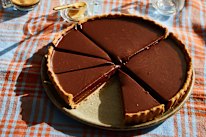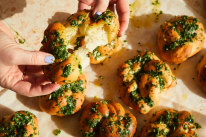The secret to these fluffy cinnamon doughnuts? It’s all in the mashed spuds
The difference between gloriously puffy doughnuts and dense, oily rings comes down to an ingredient found in the supermarket vegie aisle.
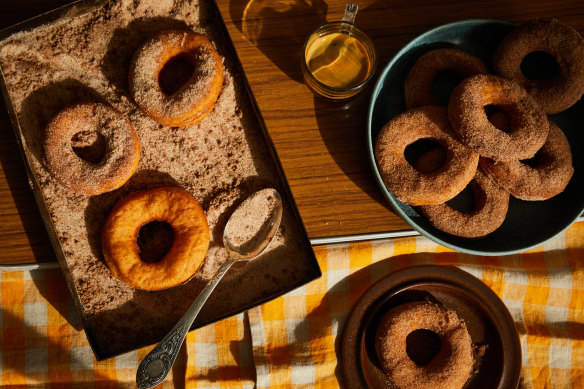
I first learnt about using mashed potato in a doughnut while watching a cooking show called Simply Ming about 15 years ago. It blew my mind! Mashed potato, in a doughnut? Outrageous! The potato – simply boiled and mashed – helps create an amazingly fluffy, light-textured dough that can’t be beaten.
Technique of the month: Replacing eggs in baking
Eggs help create one of three things in baked goods – moisture, structure or leavening. These are my favourite replacement ingredients to help you achieve similar results.
- In cakes, muffins, pancakes and cupcakes I use either ½ a banana per egg or ¼ cup of apple sauce per egg.
- In more dense baked goods, such as cookies or brownies, I use ground flax or chia seeds. Combine 1 tablespoon of ground seeds with 3 tablespoons of water and allow the mixture to sit for 1-2 minutes to thicken.
- In yeasted, gluten-developed bakes such as doughnuts, brioche and cinnamon buns, mashed potato makes the perfect replacement. I like to use 75g cooked and mashed potato per egg.
Ingredients
7g instant dried yeast
50g caster sugar
500g plain flour
pinch of salt
250ml warm water
75g rice bran oil
150g cooked, mashed potatoes, warm
2 litres neutral oil (canola or vegetable), to fry
Cinnamon sugar
100g caster sugar
1 tbsp cinnamon
Method
Step 1
Combine the yeast, caster sugar, plain flour and salt in a bowl and whisk together thoroughly to combine.
Step 2
In a separate bowl, combine the warm water, rice bran oil and mashed potatoes and mix to briefly combine. In the bowl of a stand mixer fitted with a dough hook, add the wet ingredients to the dry ingredients and knead together until the dough is cohesive and slightly elastic, about 5-7 minutes. This is quite a wet dough, so try not to add too much extra flour.
Step 3
Set the dough aside to rise for 1-1½ hours or until it has doubled in size. Meanwhile, cut a sheet of baking paper into 10cm squares. (You will need about 20.)
Step 4
Knock back the dough and roll it out to 2-3cm thick. Cut out the doughnuts using a 7cm ring cutter and a 2cm ring cutter for the centre hole and set each doughnut onto an individual square of baking paper. This allows for much easier frying as the doughnuts won’t stick to the tray during the second rise.
Step 5
Allow the doughnuts to rise a second time for 30-45 minutes, or until they have doubled in size and puffed up.
Step 6
Heat the neutral oil to 180C in a large, deep pot.
Step 7
Place a doughnut (still on its baking paper square) into the oil – this will ensure you do not knock the air out of it while getting it into the oil (the baking paper will slip off during frying). I like to fry a couple at a time – if you overcrowd the pan, the oil temperature can drop and the doughnuts may become greasy. Fry until both sides are golden brown. Once cooked, they will float immediately. Scoop them out of the oil with a spider strainer and set aside on a baking rack set over paper towels to soak up any excess oil.
Step 8
Combine the sugar with the cinnamon and roll the still-warm doughnuts into the sugar mix before serving.
TIPS
- This doughnut dough is very moist, so it can be tempting to add more flour to counterbalance this. Try to avoid adding too much as you will end up with dry doughnuts. Instead, knead the dough long enough to activate the gluten and reduce the stickiness.
- The secret to a great doughnut is allowing the dough to rise. If the dough is not given enough time to double in size and become gloriously puffy, the doughnuts will feel quite dense when fried.
- Place each doughnut on an individual square of baking paper for the second rise. This prevents them from sticking to the tray and makes it easier to transfer them to the oil without deflating.
- Ensure the oil temperature is 180C – a thermometer is advisable. If the oil is too cool, the doughnuts will become greasy. Too hot and they will burn before cooking through.
Appears in these collections
The best recipes from Australia's leading chefs straight to your inbox.
Sign upMore:
From our partners
Similar Recipes
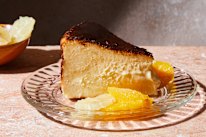
Watch for the wobble: The secret to a perfectly creamy, yet caramelised, Basque cheesecake
- 30 mins - 1 hr
- Emelia Jackson
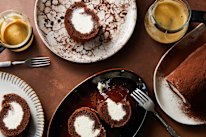
‘Simply irresistible’: The secret to a perfect, crack-free chocolate Swiss roll
- 30 mins - 1 hr
- Emelia Jackson
More by Emelia Jackson

‘Simply irresistible’: The secret to a perfect, crack-free chocolate Swiss roll
- 30 mins - 1 hr
- Emelia Jackson

